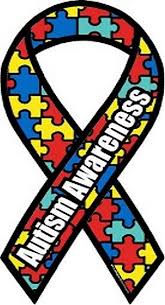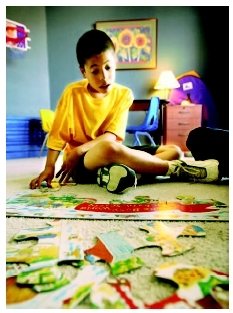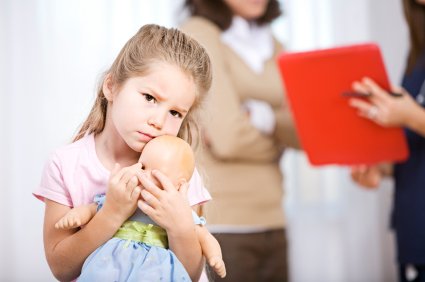 Hey you guys!This is about autism :)
Hey you guys!This is about autism :) 
Autistic disorder (also called autism; more recently described as "mindblindedness") is a neurological and developmental disorder that usually appears during the first three years of life. A child with autism appears to live in his/her own world, showing little interest in others, and a lack of social awareness. The focus of an autistic child is a consistent routine and includes an interest in repeating odd and peculiar behaviors. Autistic children often have problems in communication, avoid eye contact, and show limited attachment to others.Autism can prevent a child from forming relationships with others (in part, due to an inability to interpret facial expressions or emotions). A child with autism may resist cuddling, play alone, be resistant to change, and/or have delayed speech development. Persons with autism tend to exhibit repeated body movements (such as flapping hands or rocking) and have unusual attachments to objects. However, many persons with autism excel consistently on certain mental tasks (i.e., counting, measuring, art, music, memory).
The cause of autism is not known. Research suggests that autism is a genetic condition. It is believed that several genes are involved in the development of autism. Research studies in autism have found a variety of abnormalities in the brain structure and chemicals in the brain; however, there have been no consistent findings. One theory is the possibility that autistic disorder is a behavioral syndrome that includes several distinct conditions. However, parenting behaviors are not the cause or a contributing factor to the cause or causes of autism.The Centers for Disease Control and Prevention (CDC) reported that about one in 150 eight-year-old children in six communities studied had an autism spectrum disorder, according to the CDC’s most recent Autism and Developmental Disabilities Monitoring Network data. Autism is more prevalent in boys than girls, with four times as many boys affected than girls.

This are the most common symptoms of autism. However, each child may experience symptoms differently. Symptoms may include:
- does not socially interact well with others, including parents
- shows a lack of interest in, or rejection of physical contact. Parents describe autistic infants as "unaffectionate." Autistic infants and children are not comforted by physical contact.
- avoids making eye contact with others, including parents
- fails to develop friends or interact with other children
- does not communicate well with others
- is delayed or does not develop language
- once language is developed, does not use language to communicate with others
- has echolalia (repeats words or phrases repeatedly, like an echo)
- demonstrates repetitive behaviors
- has repetitive motor movements (such as rocking and hand or finger flapping)
- is preoccupied, usually with lights, moving objects, or parts of objects
- does not like noise
- has rituals
- requires routines
Standard guidelines have been developed to help identify autism in children before the age of 24 months. In the past, diagnosis of autism was often not made until late preschool-age or later. The guidelines can help identify children with autism early, which means earlier, more effective treatment for the disorder.According to the guidelines, all children before the age of 24 months should routinely be screened for autism and other developmental delays at their well-child check-ups. Children that show developmental delays and other behavior disorders should be further tested for autism.
The American Academy of Pediatrics recommends that all children should be screened for autism spectrum disorders (ASD) at 18 months and 24 months, regardless of whether there are any signs or concerns about a child’s developmental progress.By screening children early for autism, those diagnosed with the disorder can be treated immediately and aggressively.The standardize guidelines developed for the diagnosis of autism actually involve two levels of screening for autism. Level one screening, which should be performed for all children coming to a physician for well-child check-ups during their first two years of life, should check for the following developmental deficits:
- no babbling, pointing, or gesturing by age 12 months
- no single words spoken by age 16 months
- no two-word spontaneous (non-echolalic, or not merely repeating the sounds of others) expressions by age 24 months
- loss of any language or social skills at any age
- no eye contact at 3 to 4 month
The second level of screening should be performed if a child is identified in the first level of screening as developmentally delayed. The second level of screening is a more in-depth diagnosis and evaluation that can differentiate autism from other developmental disorders. The second level of screening may include more formal diagnostic procedures by clinicians skilled in diagnosing autism, including medical history, neurological evaluation, genetic testing, metabolic testing, electrophysiologic testing(go find out what it mean), psychological testing, among others.Genetic testing involves an evaluation by a medical geneticist (a physician who has specialized training and certification in clinical genetics), particularly as there are several genetic syndromes which may cause autism, as well as a variety of chromosome abnormalities. A geneticist can determine whether the autism is caused due to a genetic disorder, or has no known genetic cause. If a genetic disorder is diagnosed, there may be other health problems involved. The chance for autism to occur in a future pregnancy would depend on the syndrome found. In cases where no genetic cause for the autism is identified, there is still a slightly increased chance for a couple to have another child with autism, with ranges averaging from 3 to 7 percent. The reason for this increase over the general population is thought to be because autism may result from several genes inherited from both parents acting in combination, in addition to unknown environmental factors. There is no action/inaction known that parents could have done, or did not do, to cause autism to occur in a child.
Specialized behavioral and educational programs are designed to treat autism. Behavioral therapy is used to teach social skills, motor skills and cognitive (thinking) skills. Behavior modification is also useful in reducing or eliminating maladaptive behaviors. Individualized treatment planning for behavioral therapy is important as autistic children vary greatly in their behavioral needs. Intensive behavior therapy during early childhood and home-based approaches training and involving parents are considered to produce the best results.Special education programs that are highly structured focus on developing social skills, speech, language, self-care, and job skills. Medication is also helpful in treating some symptoms of autism in some children. Mental health professionals provide parent counseling, social skills training, and individual therapy. They also help families identify and participate in treatment programs based on an individual child's treatment needs. Specific treatment will be determined by your child's physician based on:
- your child's age, overall health, and medical history
- extent of the disorder
- your child's symptoms
- your child's tolerance for specific medications or therapies
- expectations for the course of the disorder
- your opinion or preference






No comments:
Post a Comment